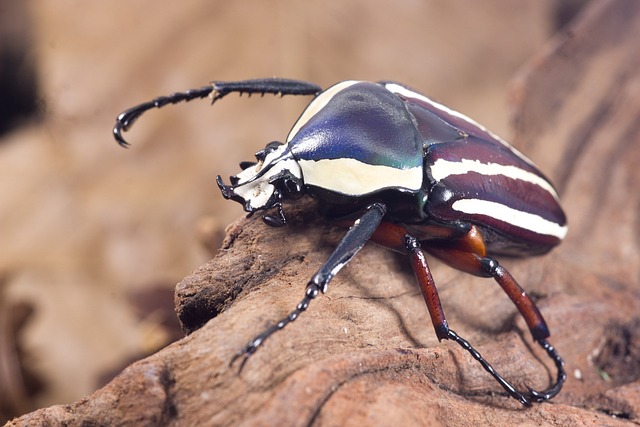Cigarette beetles (Lasionella tacita) pose a significant threat to organic materials in homes, museums, libraries, and archives due to their attraction to cellulose-rich items. Early detection is crucial as these tiny pests hide in crevices, causing structural damage and unsanitary conditions through larval frass. Regular inspections and proactive measures are essential for effective cigarette beetle treatment. Professional methods include pheromone traps and specialized lighting. Strategies involve chemical treatments, physical removal of contaminated materials, prevention techniques (regular cleaning, proper ventilation), and long-term maintenance programs to create an inhospitable environment for the pests, providing sustained protection over time.
“Maintaining a beetle-free environment is crucial, especially in spaces prone to cigarette beetle infestations. This comprehensive guide explores effective strategies to combat these tiny invaders and their significant impact on storage areas. We delve into understanding the behavior and signs of cigarette beetles, offering insights for early detection.
The article provides a step-by-step approach to treatment, ensuring successful elimination. Furthermore, it highlights the importance of ongoing maintenance programs as a long-term solution, empowering readers with practical tips to prevent future cigarette beetle treatments.”
Understanding Cigarette Beetles: Behavior and Impact
Cigarette beetles, scientifically known as Lasionella tacita, are tiny yet formidable pests that can infiltrate and devastate various spaces, from homes to museums. These beetles are attracted to organic materials, particularly those containing cellulose, making them a menace in environments with high-fiber content like paper, wood, or textiles. Understanding their behavior is crucial for effective cigarette beetle treatment. They often lurk in hidden areas, such as crevices and voids, where they can go unnoticed until an infestation takes hold. Their ability to remain dormant for extended periods adds to the challenge of eradication.
The impact of these beetles can be severe. They not only cause structural damage by boring into wood but also contaminate materials with their larvae’s frass (excrement), leading to unpleasant odors and unsanitary conditions. In sensitive environments like libraries, archives, or historical sites, an infestation can result in irreversible damage to irreplaceable artifacts. Therefore, proactive measures and regular inspections are essential to identify cigarette beetle presence early on, ensuring swift and effective treatment.
Identifying Signs of Infestation and Early Detection Methods
Identifying signs of infestation is crucial in the battle against cigarette beetles. One of the earliest indicators is the presence of small, round holes in wood or cardboard, which are often the result of adult beetles emerging from their pupal cases. As the infestation progresses, you may notice a fine, powdery dust on surfaces, as these beetles shed their wings after emerging. The telltale sign includes also the sight of tiny, C-shaped larvae wriggling within damaged materials, especially in hidden crevices. Regular inspections are key; examining susceptible items frequently can help detect any early signs of an infestation, allowing for swift cigarette beetles treatment and prevention of further damage.
Early detection methods play a vital role in managing these pests effectively. Traps baited with pheromones or attractive substances can be placed in strategic locations to monitor beetle activity. Additionally, employing specialized lighting can attract and trap adult beetles, providing valuable data on their presence and movement patterns. These proactive measures enable professionals to implement targeted cigarette beetles treatment plans, ensuring a successful eradication while minimizing the impact on surrounding environments.
Implementing Effective Cigarette Beetle Treatment Strategies
Implementing effective cigarette beetle treatment strategies is paramount in achieving and maintaining a beetle-free environment. The first step involves identifying the extent of the infestation through thorough inspections, which help pinpoint the source and scope of the problem. Once detected, prompt action is crucial; early intervention can prevent the beetles from breeding and spreading. Professional pest control services often recommend a multi-pronged approach, combining chemical treatments with physical removal and prevention methods.
Chemical treatments should target both adult beetles and their larvae. Professional exterminators use insecticides that are effective against cigarette beetles but safe for humans and pets. Physical removal involves eliminating hiding places and discarding contaminated materials to deprive the beetles of shelter and food sources. Prevention is key; regular cleaning, proper ventilation, and maintaining a clean environment significantly reduce the risk of future infestations.
Long-term Prevention: Ongoing Maintenance Programs for Beetle-free Environments
Implementing long-term prevention strategies is key to maintaining a beetle-free environment, and one of the most effective approaches is adopting ongoing maintenance programs. These programs focus on proactive measures to deter and eliminate cigarette beetles, ensuring their elimination and preventing future infestations. Regular inspections and monitoring are vital components, allowing for early detection of any signs of an emerging infestation.
By integrating a comprehensive set of practices, such as regular vacuuming and cleaning, the removal of potential hiding spots, and the use of insect traps, these maintenance programs create an inhospitable environment for cigarette beetles. Additionally, sealing entry points and maintaining proper ventilation can further strengthen the defense against these pests. This multi-faceted approach to cigarette beetles treatment not only provides immediate relief but also guarantees sustained protection over time.
To maintain beetle-free spaces, implementing ongoing maintenance programs is key. Regular inspections, prompt removal of debris, and monitoring for early signs of infestation are essential components of successful long-term prevention. By combining these strategies with effective treatment methods, facilities can significantly reduce the risk of cigarette beetle invasions, ensuring a peaceful and pest-free environment. Remember, proactive measures are crucial in the fight against these relentless intruders, allowing you to enjoy spaces free from their presence.
